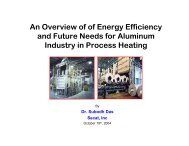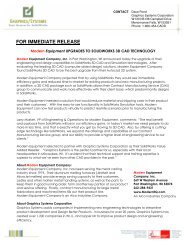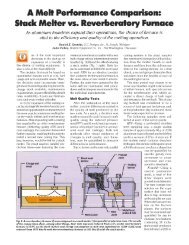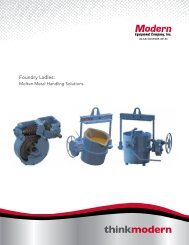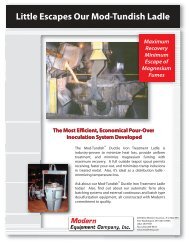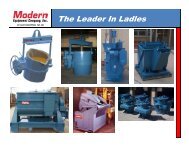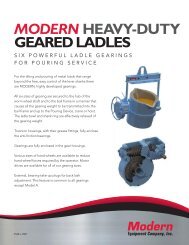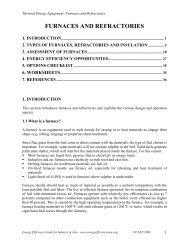ITP Metal Casting: Advanced Melting Technologies: Energy Saving ...
ITP Metal Casting: Advanced Melting Technologies: Energy Saving ...
ITP Metal Casting: Advanced Melting Technologies: Energy Saving ...
You also want an ePaper? Increase the reach of your titles
YUMPU automatically turns print PDFs into web optimized ePapers that Google loves.
3.4 Selecting Appropriate <strong>Melting</strong> Technology<br />
Industrial operations have to address a broad range of considerations that have a direct effect on<br />
their “bottom line” when faced with the choice of melting technologies. These factors include:<br />
• Space availability (floor space & height) • Capital investment<br />
• Type and variety of alloys to be melted • Quantity of the metal required<br />
• Fluctuations in metal demand during operation • Alloying requirement<br />
• Quality of the metal • Operating costs, especially in labor<br />
• Quantity of dross/slag • Reliability of the equipment<br />
• Emissions and environmental considerations • Durability of the furnace<br />
• Maintenance requirements<br />
Since each foundry may attribute a different priority to each one of these factors, there is no<br />
“one-size-fits-all” decision in the selection of melting technologies. <strong>Energy</strong> efficiency is not<br />
necessarily the only significant criterion in selecting melting equipment. Where energy costs are<br />
high (e.g., in Europe), energy efficiency has been an operating priority for many years. For<br />
example, stack furnaces are more common than reverberatory furnaces for melting aluminum in<br />
Europe. However, in the United States, 95% of aluminum is melted in gas reverberatory<br />
furnaces, which operate with energy efficiency of 20-30% but require lower capital cost and<br />
provide easier operation and maintenance than stack melters.<br />
A furnace design must meet some requirements to provide for an efficient melting process.<br />
These requirements include the ability to produce high-quality metal, to accurately control bath<br />
temperatures, to minimize metal losses, and to meet environmental concerns, while maintaining<br />
high energy efficiency. Although the cost of fuels, metals and labor are constantly changing<br />
variables, energy efficiency will always be an important consideration, especially in the face of<br />
the current trend of rapidly rising energy costs. Improving efficiency of melting, while<br />
addressing all other aspects of the operation, is critical in keeping the metal casting industry<br />
competitive. 12<br />
4. Current and Emerging <strong>Melting</strong> <strong>Technologies</strong> and<br />
Practices<br />
This section of the report describes different types of melting technologies that are currently used<br />
in the metal casting industry. It discusses their benefits, technical barriers, and scale-up issues,<br />
and examines advances in furnace technologies that improve energy efficiency and reduce melt<br />
loss. Non-conventional melting technologies are included even though their practical application<br />
may be limited, as they offer alternative approaches and add to our knowledge base in the<br />
melting technology field. Additionally, the more practical energy-saving opportunities are<br />
described, such as retrofits for existing furnace systems, changes in fuel source, and best<br />
practices.<br />
9



